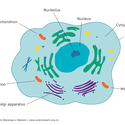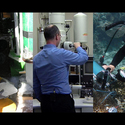RNA interference1 (RNAi) is a biological process in which RNA2 inhibits gene expression3. It is a natural process in cells. As a biotechnology tool, RNA interference4 ‘silences’ a gene5 by using a synthetic6 RNA sequence to prevent translation7.
RNAi – a socio-scientific issue
RNAi8 was hailed by the journal Science as the “Breakthrough of the Year” in 2002, and the scientists who discovered it won the Nobel Prize9 in Medicine or Physiology10 in 2006. Since its discovery, much of the science that underpins RNAi has become well established. RNAi is widely used in research to study gene function, in medicine to identify potential therapeutics11 and in biotechnology to improve crop12 yields and control13 pests.
In Aotearoa14, pockets of public unease remain about the use of novel15 gene technologies, so using RNAi to resolve local issues like pest control16 continues to be an area of debate. New Zealand’s Biological Heritage National Science Challenge notes that, “Issues such as use of outdated technology, critical knowledge gaps, and lack of public awareness due to the poor links between science and action make this problem complex.”
There are also government regulations. The Ministry for the Environment defines a genetically modified17 organism18 as, “A plant, animal, insect or micro-organism whose genetic19 make-up has been changed using modern laboratory techniques. For example, new genes20 might have been added or the function of genes already present might have been altered. New genes may contain sequences found in the same or different species21 or they may be synthetic.” The Hazardous Substances and New Organisms Act (HSNO Act) regulates research into and the release of all living things that do not already exist in New Zealand, including those that are genetically modified. The Environmental Protection Authority considers applications to import, develop, field test or release any new organism22 (including a genetically modified organism).
Mātaiaho – weaving learning within and across learning areas
Socio-scientific23 issues help to develop students’ critical-thinking and problem-solving skills as well as their science capabilities. They are often value laden, so they present opportunities for cross-curricular student inquiry and learning.
As a biological process, RNAi combines a number of biology24 basics and brings them to life in an authentic context. In the New Zealand Curriculum, learning about RNAi sits within the Living World – Evolution25 strand:
- Level 7: Understand that DNA26 and the environment interact in gene expression.
- Level 8: Understand how humans manipulate the transfer of genetic information from one generation to the next and make informed judgments about the social, ethical, and biological implications relating to this manipulation.
As a socio-scientific issue, RNAi sits within the Nature of science27 – Participating and contributing strand.
- Levels 5–6: Develop an understanding of socio-scientific issues by gathering relevant scientific information in order to draw evidence-based conclusions and to take action where appropriate.
- Levels 7–8: Use relevant information to develop a coherent understanding of socio-scientific issues that concern them, to identify possible responses at both personal and societal levels.
In Te Mātaiaho, learning about RNAi in a social context sits within Te ao tangata Social sciences – Interactions change societies and environments:
- Understand: Relationships and connections between people and across boundaries lead to new ideas and technologies, political institutions and alliances, and social movements.
- Do: Communication using evidence28, logic, social science concepts and conventions, and an awareness of audience and purpose enables us to express and share our views and supports participation.
- Do: Working collaboratively to consider possible solutions to social issues enhances decision making and strengthens evidence-based, ethical responses.
Resources to support learning
The Science Learning Hub – Pokapū Akoranga Pūtaiao has partnered with the BioHeritage Science Challenge to create resources about RNA interference and its potential uses within Aotearoa as pest control:
- RNA interference – article
- Using RNAi to control varroa mites – article
- Using RNAi to combat myrtle rust – article
- RNAi for pest control – te ao Māori considerations – article
- New Zealand's Biological Heritage – Ngā Koiora Tuku Iho – article
- RNA interference – key terms – article
- RNAi – making science-informed responses – activity
Learning about RNAi and its potential for pest control supports students to develop skills in:
- critiquing sources of information
- analysing the relevant biological knowledge
- identifying the potential social implications
- analysing these implications from multiple perspectives
- articulating and justifying their own positions.
Nature of science
Socio-scientific issues – such as the use of RNA interference as a biotechnology tool – highlight the relationship between science, technology and society. Although the science and technology that underpin RNAi is well established, societal and cultural concerns need to be considered.
Related content
The following resources provide helpful background information:
- DNA, chromosomes and gene expression
- Proteins – what they are and how they’re made
- Cell biology and genetics
- The genotype/phenotype connection
- Identifying Mendel’s pea genes (gene expression)
The article Modern biotechnology has other examples of genetic modification29.
The article Impacts of biotechnology on society explores interacting factors that influence thinking about biotechnology.
The Connected article Fake facts looks at misinformation30, malinformation31 and disinformation32 in the online media landscape. It also suggests strategies for evaluating whether information is based on facts and whether it is worth sharing.
Activity ideas
The Ethics thinking tool kit provides you and your students with a framework for unpacking these complex issues.
Useful links
The Ministry for the Environment booklet Genetic modification – the New Zealand approach, published in 2004, aims to answer some of the basic questions you might have about what genetic modification is, how applications to use it can be made and how they are controlled and managed in New Zealand.
Read the 2019 report Gene editing – legal and regulatory implications from the Royal Society Te Apārangi.
Visit the New Zealand’s Biological Heritage – Ngā Koiora Tuku Iho website:
- RNA interference (RNAi): The process when a double-stranded RNA molecule prevents a messenger RNA (mRNA) molecule from being translated into a protein. Also called RNA silencing or RNA inactivation.
- RNA: A molecule generated in cells by transcription and required for the synthesis of proteins. RNA (Ribonucleic acid) is made up of a large number of nucleotides to form a long single strand. A chemical code for genetic information.
- gene expression: The use of a gene to make a protein. Involves transcription of the DNA sequence into RNA and translation of the RNA into an amino acid sequence (or protein).
- interference: The simultaneous presence of two or more waves in the same position, resulting in a new wave pattern.
- genes: A segment of a DNA molecule that carries the information needed to make a specific protein. Genes determine the traits (phenotype) of the individual.
- synthetic: Made in a laboratory or factory by a chemical process, usually to imitate a natural process.
- translation: The process in which a messenger RNA (mRNA) sequence is used as a template to form a sequence of amino acids (a protein). Occurs after transcription.
- RNA interference (RNAi): The process when a double-stranded RNA molecule prevents a messenger RNA (mRNA) molecule from being translated into a protein. Also called RNA silencing or RNA inactivation.
- Nobel Prize: An annual, prestigious international award for achievement in physics, chemistry, physiology or medicine, literature and peace.
- physiology: A branch of biology that studies the functions and activities of living organisms, including all physical and biochemical processes.
- therapeutics: The branch of medicine focusing on the treatment of disease and how medicines work.
- crop: 1. In agriculture, a cultivated plant that is grown on a large, commercial scale. The term most often refers to cereals, fruits and vegetables. 2. A compartment of muscle tissue that birds use to store and soften their food before it moves on to be processed by the gizzard.
- control: 1. Part of a scientific experiment in which no treatment has been applied in order to see whether there are any detectable differences to the experiment that did receive a treatment. 2. To hold in check or to curb.
- Aotearoa: The Māori name for New Zealand, meaning Land of the Long White Cloud.
- novel: New or unusual in an interesting way.
- pest control: The management of species defined as a pest.
- genetically modified: An organism (plant, animal, bacterium or virus) whose genome has been altered by human intervention. Alterations can include the addition or deletion of DNA sequences and the introduction of DNA sequence changes.
- organism: A living thing.
- genetic: Of, relating to, or determined by genes.
- genes: A segment of a DNA molecule that carries the information needed to make a specific protein. Genes determine the traits (phenotype) of the individual.
- species: (Abbreviation sp. or spp.) A division used in the Linnean system of classification or taxonomy. A group of living organisms that can interbreed to produce viable offspring.
- new organism: Any organism that is coming into New Zealand for the first time. Examples include introduced or genetically modified organisms.
- socio-scientific: Combining social and scientific factors.
- biology: The science of living things.
- evolution: In biology, the change in the genetic material and/or the behaviour of a population of organisms over time.
- DNA: Deoxyribonucleic acid (DNA) is a molecule that contains the instructions needed for an organism to develop and function. These instructions are stored as a code made up of four chemical bases: adenine (A), guanine (G), cytosine (C) and thymine (T).
- nature of science: The Nature of Science (NoS), is an overarching and unifying strand of the New Zealand science curriculum. Through it, students develop the skills, attitudes and values to build a foundation for understanding the world around them – understanding how science works in order to make links between scientific knowledge and everyday decisions and actions.
- evidence: Data, or information, used to prove or disprove something.
- genetic modification: Genetic modification (GM) is any process that changes the genetic material of an organism (plant, animal, bacteria or virus) in order to make it capable of producing new substances or performing new or different functions.
- misinformation: Information that is wrong, but it is not shared in print or online media with the intent to hurt someone or something.
- malinformation: Information that is intentionally shared in print or online media to harm someone or something, but it is not based on false information.
- disinformation: Information that is intentionally shared in print or online media to harm someone or something, and is based on false information. This is usually done to influence people to think a certain way.







